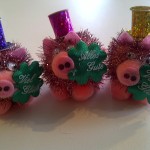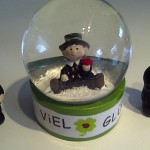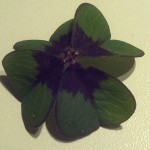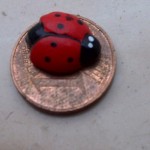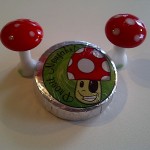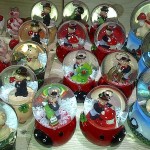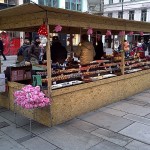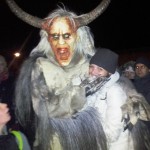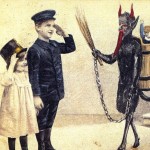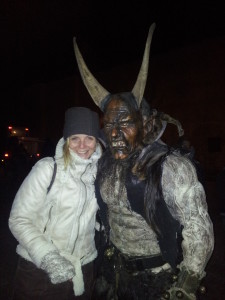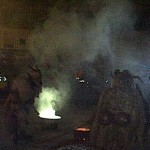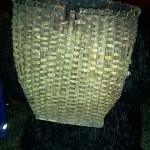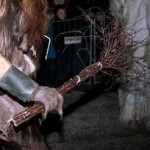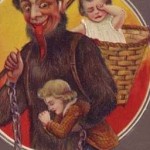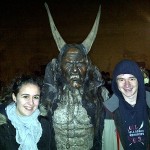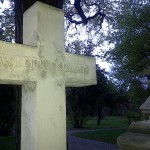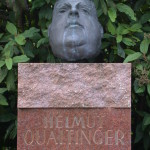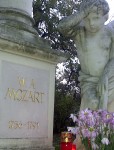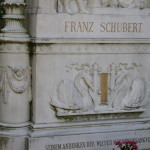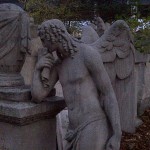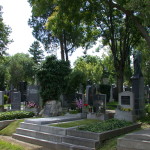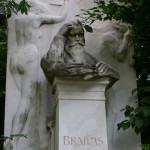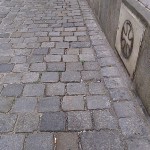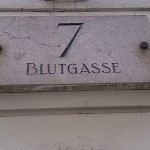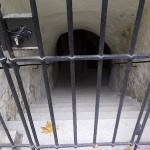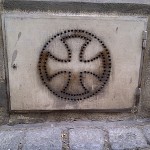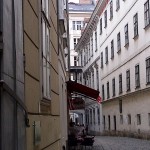Got Glück? Good Luck Charms /Glücksbringer (Good luck bringers)
“You know, Hobbes, some days even my lucky rocketship underpants don’t help.”– Bill Watterson, Calvin & Hobbes
A long standing tradition in Austria is for people to give each other good luck charms on New Year’s Eve. So in Vienna as Christmas market kiosk owners seal shut boxes of unsold ornaments and nativity scenes, New Year’s market kiosk owners unpack boxes of plush pigs, chocolate chimney sweeps and plastic horseshoes. Good luck charm enthusiasts will exchange over ten million trinkets on New Year’s Eve and will individually dish out anywhere between 5 to 20 Euros for their charms. In fact 6 out of 10 Austrians can’t resist stopping when a New Year’s kiosk is near though I would wager that the number of Austrians who can’t resist stopping when a Glühwein stand is near is higher.
THEY BRING GOOD LUCK
Chimney Sweep / Rauchfangkehrer (smoke catch sweeper, pronounced: Rawch fong carer): By freeing the chimneys of soot and grime, chimney sweeps reduced the risk of fires in the households and whose going to argue that not having a fire destroy all that you own is very good luck. Besides, those chimney sweeps do look snazzy in their uniforms. And this all reminds me of the song, Chim Chim Cheree, from Mary Poppins which I think it is high time to introduce to the Austrians (yes, English nannies fly around London singing with their umbrellas).
So watch the video AND the bouncing ball and engage in pure unadulterated fun for a whole two minutes and 41 seconds by closing your door, turning up the volume and stripping away all your inhibitions to sing along – who can be a sour puss after singing that? Check out just the lyrics if you want to practice some before hitting the karaoke bar with your Mary Poppins gig.
Four Leaf Clovers / Glücksklee (lucky clover, pronounced: Glue kss clay): Because they appear so seldom in nature, they bring good luck. And according to legend, Eve carried a four leaf clover with her when leaving the Garden of Eden. Also, the clover is a symbol for the cross and should make secret wishes come true. Remember the song: “I’m looking over a four-leaf clover That I overlooked before. One leaf is sunshine, the second is rain, Third is the roses that grow in the lane. No need explaining the one remaining Is somebody I adore.
I’m looking over a four-leaf clover That I overlooked before. ” (check out the Four Leaf Clover video in case you think KC’s finally fallen off her rocker) Imagine! You could do a Mary Poppins-Emmy Rossum medley. If you’re checkin out Emmy Rossum anyway, listen to Sentimental Journey – smooth and sultry to put you in the right mood for your New Year’s Eve celebrations – great stuff. And also, I recommend the Chevy Chase version of Four Leaf Clover that gets good by the second refrain.
Horseshoe / Hufeisen (hoof iron, pronounced: whoof ay sin):
In earlier times, horses were valuable working animals and the horse shoes protected them. If you hang a horseshoe above the door, definitely make sure you have nailed it in good and the open end is pointing towards the sky so the good luck doesn’t run out (don’t you hate when that happens?).
Lady Bug / Marienkäfer / Glückskäfer (Marian beetle / Good luck beetle, pronounced: Ma ree an Kay fer): The lady bug is called “Marian Beetle” in German and symbolizes a gift from the Holy Mother Mary to earth. The lady bug protects the young and old, and heals the sick and weak. And, of course, killing or injuring a lady bug will bring bad luck, and not just for the lady bug. Perhaps lady bugs bring good luck because they have up to seven black spots on their backs and in German-speaking countries the number seven is considered lucky. So in Austria a cat has seven, not nine lives here (so go Anglo Garfield). If you are in love in German-speaking countries, you are hanging out on cloud seven, not cloud nine so check your country before picking your cloud.
Lucky Cent / Glückscent (pronounced: Glue kss cent): an old lucky cent was made of copper which was said to chase away black magic and strengthen the power of love. As protection from witches, people nailed a votive cent to the doors or their stalls. And if you carried a lucky cent in your pocket, it protected you from lies and trickery at the pub and cattle market. Something to consider next time you find yourself wrangling for some bulls at the old cattle market. And the reason why finding a cent is lucky (particularly if you manage to pick it up without herniating a disk, getting pancaked by a City Bike or tipping some shopping trolley wielding Oma with your derrière) is because all great things start small. “Wer das Kleine nicht ehrt, ist das Große nicht wehrt” He who does not appreciate the small is not worth the great.
Pig /Glücksschwein (good luck pig, pronounced Glue kss sh vine): See my entire blog entry about why the pigs bring good luck in Austria: Got Pig?
Toadstool /Fliegenpilz (fly mushroom, pronounced: Flee gen pil ts): In many ancient cultures (and in some not-so-ancient ones, ahem) poisonous mushrooms were used as hallucinogenic drugs and and were therefore considered a good luck charm (good luck if the toad stool didn’t kill you or cause you severe stomach cramping in the process, I suppose). And apparently, they are called “fly mushroom” in German because flies seek them out to get high. “Hey! Check out that shroom! I’m going in.” Who knew flies have drug problems. And depending if they are used for good or evil, they can also be considered tools of the devil (“Now where did I put that toadstool?”). In case you are dying to know this and more useless facts about toadstools, check out Amanita muscaria on Wikipedia
TIP: Buy your loved ones a good luck charm at a kiosk now until New Year’s at stalls popping up everywhere throughout the city or pick up a charm for yourself in Vienna on Tuesday, December 31 between 2 and 5 pm in the Chimney Sweep Museum / Rauchfangkehrer Museum in the Klagbaumgasse 4, 1040 Vienna. A glass of champagne awaits the adults and a chocolate chimney sweep the kids but maybe you can sweet talk your way to a chocolate or rescue a poor child from the risks of tooth decay by taking his or hers. To get there: take Tram 1 to Johann Strauß Gasse and walk 3 minutes (100 meters) or take U1 to Taubstummengasse and walk 11 minutes (600 meters)
Read more here:
(in German) Article from the Austrian Krone Newspaper, December 26, 2012 entitled “Zehn Millionen Glücksbringer jedes Jahr verschenkt” (“Ten Million Good Luck Charms Given Away Every Year”)
A Johann Wolfgang von Goethe poem for New Year’s entitled “Zum neuen Jahr” – Goethe is simply great, isn’t he? 
QUOTES ABOUT LUCK
“Glück ist meistens wie die Brille, nach der man vergebens sucht. Man findet sie nicht, weil man sie schon auf der Nase hat.“ (Luck is like eyeglasses that you look for but never find because they are already sitting on your nose). – Paul Hörbiger, Austrian actor who died in 1981.
“Nicht das, was wir sind und haben, bestimmt unser Glück, sondern das, was wir glauben zu sein und zu haben.” (Not that which we are and have determine our luck, but rather, that which we believe to be and to have). – Peter Rosegger, Austrian writer and poet (1843 – 1918)
“Dort, wo du nicht bist, da ist das Glück.” (There, where you are not, there is where luck is). – Franz Schubert, Austrian composer

